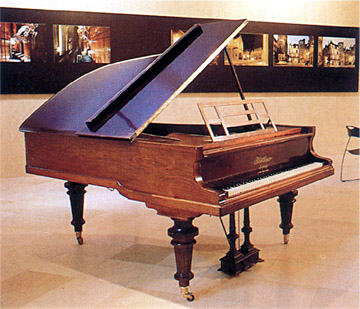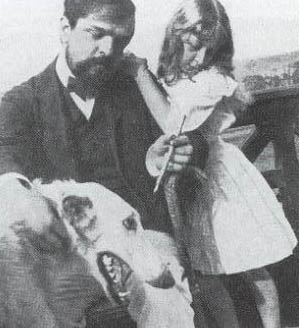
Debussy in Jersey by Diane Enget Moore - Page 4
Home Introduction Biography Jersey, 1904 Music Links
Debussy's Blüthner Grand Piano
The Jersey Theory The Eastbourne Theory An Added Mystery
The next topic I’d like to look at with regards to Debussy’s stay in Jersey is the alleged purchase of a Blüthner grand piano whilst in on the island. According to his stepdaughter Hélène Bardac (1892-1985, nicknamed Dolly, and who later became known under her married name Madame Gaston de Tinan) he purchased a 1904 Blüthner grand piano (1,92m long and 1,51m wide, equipped with the unique Aliquot system) here on the island which then remained in his salon for the rest of his life. She mentioned this fact during a lecture in London on December 18th 1972. The piano is now at the Musée Labenche in Brive-la-Gaillarde, Limousin.

(Debussy's Blüthner at the Musée Labenche)
Dolly Bardac’s lecture, given at the National Sound Archive (then the British Institute of Recorded Sound), is a very warm homage to her stepfather, and she says that although Debussy could not speak any English, he was a great Anglophile, and often it was either herself or Emma, her mother, who would translate articles from papers and books. In addition:
“He had a great partiality for the paintings of Turner and Whistler and the drawings of Arthur Rackham, one of which inspired the Prelude “Les fées sont d’exquises danseuses”. Neither must we forget other titles of British inspiration: Children’s Corner, Homage to Samuel Pickwick Esq, Puck’s Dance, and finally The Blessed Damozel of the pre-Raphaelite painter and poet, Dante Gabriel Rossetti. He was equally Anglophile in his liking for beautiful silver for the table, for whisky and for the very strong tea which he prepared himself for breakfast… Debussy had occasion to go to Britain several times. He went on holiday to Jersey in 1904, where he bought a Blüthner grand piano, the tone of which had particularly pleased him, and then he went to Eastbourne in 1905.” She also speaks sof the trips to London she made with her stepfather at later stages.

(Dolly Bardac with Debussy in Pourville, June 1904,
© cliché Bibliothèque Nationale de France, Paris)
The Blüthner grand piano has taken up quite a bit of my research time. Dolly Bardac was only 12 years old at the time of the Jersey trip (and she did not come here, although she did accompany her mother and Debussy to Pourville in June, therefore a month earlier), yet we are told by those who knew her that her memory was exceptionally good. Jean-Michel Nectoux, a Debussy expert, told me at the start of my quest : « j'ai connu Dolly de Tinan, sa mémoire était très bonne, elle avait dû entendre sa mère raconter l'épisode de l'achat du piano pendant le fameux séjour de 1904 à Jersey ».
So obviously, with such exciting information at hand, I felt compelled to try and find out more about the “Jersey” Blüthner piano, to find some sort of documentation regarding the purchase of the piano in Jersey. After all, this is quite a significant purchase. It’s not the kind of thing most tourists to the island would acquire, and naturally it would require transportation back to France after the stay.
Through the Musée Labenche where the piano now is, I was able to verify a number of factors. Firstly, it was Raoul Bardac, Debussy’s stepson (Dolly's brother) who inherited the piano when Debussy died in 1918. During World War II Raoul Bardac moved to the area around Brive-la-Gaillarde, and on his death in 1950, his widow inherited the piano. When she died, she left it to her doctor. When her doctor died, his heirs sold it to a local antique shop. The museum purchased it from the antique shop. The precise age of the piano has been verified by the Musée Labenche. Indeed, according to its serial number, this Blüthner piano was produced in the early months of 1904. Furthermore, it was resold via the piano vendor and Blüthner agent S. Hermitage & Sons.
However, having scoured the Almanacs for 1904 and 1905 at the Societé Jersiaise, I was unable to find any mention of a Hermitage & Sons firm here on the island, the only piano dealers being McKee, Donaldson, Milne and Lee. Further investigations on the mainland led to the firm in question. S. Hermitage & Sons was a piano firm specialising in the import of foreign pianos and was presumably a Blüthner agent. The piano firm had offices in London at Clapham, also in St. Leonard’s and Hastings, but most importantly at Eastbourne.
Eastbourne Library informed me in a letter:
Thank you for your enquiry
regarding S. Hermitage & Sons. I have located the business in the 1904, 1905 and
1906 Gowland's Eastbourne Directories (street). The business was situated in the
main shopping area of the town:
1904 it was between 56 and 58 Terminus Road.
1905 it was between 56 and 58 Terminus Road
1906 it was between 58 and 60 Terminus Road (It would appear that the numbers
changed, not the location)
The entry in the directories is as follows:
Hermitage, S., and Sons, English and foreign piano merchants. Also at Hastings and St Leonard's, and London, S.W.
Eastbourne. This is surely
no coincidence! After all, Debussy spent a month in Eastbourne in 1905! Could it be that the so-called Jersey piano was
purchased in Eastbourne and not Jersey?
Unfortunately, the firm S. Hermitage & Sons no longer exists, and it seems
impossible to locate any specific records for them.
Some researchers I have spoken to seem quite adamant that Dolly Bardac had an impeccable memory, but what if she was quite simply repeating something she thought was true?
One of the UK’s leading piano historians, Bill Kibby-Johnson of The Piano History Centre, to whom I asked these questions, told me the following: “The problem is that it is almost impossible to say that a piano made in 1904 even left the factory in 1904, unless their archives have proved it.” (And Blüthner’s old records were all destroyed during the bombing of Leipzig in 1943.) Secondly, he adds: “some pianos didn't even come out of the factories for a year or three. Then they didn't sell immediately, so dating a piano even to a year is unreliable.” And looking at it logically, the serial number of the Blüthner which definitely states it was made in the first trimester of 1904, means that if within a matter of 3 months it was made, exported to Britain and then re-transported to Jersey to be bought by Debussy, it seems a bit too tight a schedule for the epoch. In addition, had it been resold by one of the Jersey firms, such as Donaldons, it would also have their own identification on it. Furthermore, Debussy would have had to organise transport back to France, and did his stay in Jersey give him enough time to do this?
The fact that the piano vendors had offices and a store in Eastbourne, in Terminus Road which was literally yards from the Grand Hotel where he and Emma Bardac stayed in 1905, seems to point most clearly to the Eastbourne theory.
Indeed, I have even more evidence to suggest that this so-called Jersey Blüthner is in fact an Eastbourne acquisition. Although Debussy does not mention the grand piano in his Eastbourne correspondence, I did come across a very exciting piece of evidence in some of the memoirs of his former friends and students. One such man, Maurice Dumesnil, who went on to be a reputed but minor composer in his own right, had the following to say in an essay published in 1962, describing Debussy’s parlour at his house in the Bois de Boulogne: “Almost in the middle of the room, the black Blüthner grand stood, free of music, book or photographs. // He was proud of his grand piano, and before I played he showed me a new device invented by Blüthner: an extra string set on top of the others. Although not touched by the hammers, it caught the overtones, thus increasing the vibrations and enriching the sonority. This was a piano he had rented during a stay in Bournemouth, and liked so well that he had bought it and had it shipped to Paris.” “He played a number of passages and the tone he extracted from the Blüthner was the loveliest, the most elusive and ethereal I have ever heard”. Obviously, we have the confusion here of Bournemouth and Eastbourne. We do know that Debussy didn’t go to Bournemouth, and geographically the two seaside towns are not close to each other, but on the other hand, for a foreigner, the names do have some similarities, and I feel this is a slip of the tongue. (Having spoken to Jean-Michel Nectoux about all these latest developments in the Blüthner saga, he agrees that “c'est Eastbourne qu'il faut lire”.)
An added mystery is the following: Have another look at the piano kept at the Musée Labenche. Look at the colour of the piano. It is mahogany, not ebony black as described by Dumesnil. "Almost in the middle of the room, the black Blüthner grand stood, free of music, book or photographs." We know from Dumesnils’ own description of the room that it was discreetly lit with sunlight filtering through blue curtains, and we know from other visitors to Debussy’s home, such as Alfredo Casella that the Bois de Boulogne house was always bathed in light, as Debussy could only work in light environments, not in the dark. Debussy only had three pianos in his house: an upright Pleyel which was a gift from the manufacturer, another upright piano which was a Bechstein, and the Blüthner grand. Having consulted historic piano expert and recording engineer Christopher Greenleaf of Avondale, Rhode Island, one can but assume that this Blüthner, "indeed made of mahogany, was originally lacquered in black, and that when restored the lacquer had come to be in poor shape and was stripped to reveal the attractive wood."
And finally...
What quality of sound can we imagine the 100-year-old piano to have today? My thanks to Roy Howat of the Royal Academy of Music, London, who kindly sent me this note (October 2005): "I've just had the pleasure of playing the piano in Brive -- one can hear it must have been a lovely instrument, and it still plays (and sustains) very well, though I think the museum were right not to over-restore it."